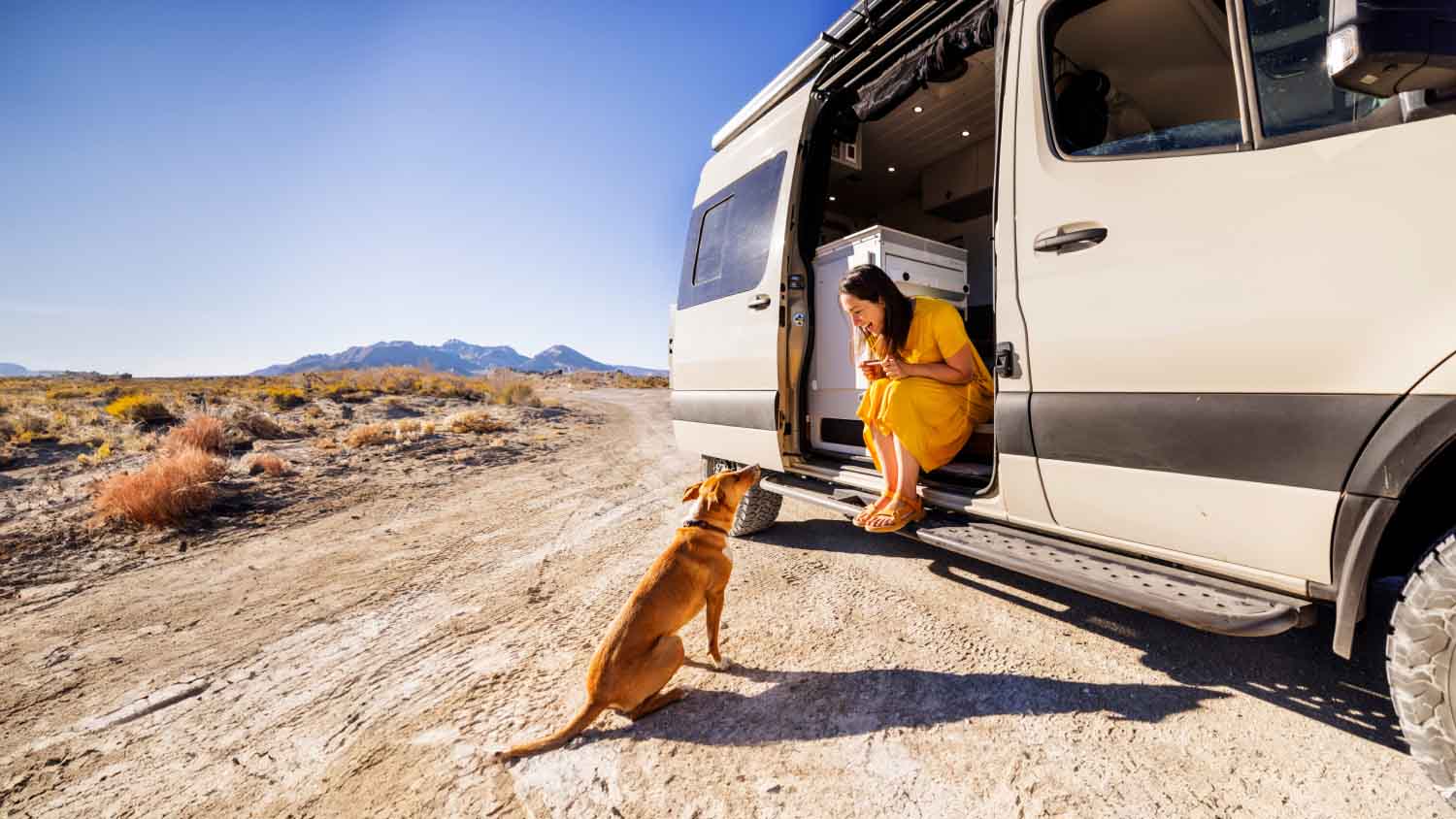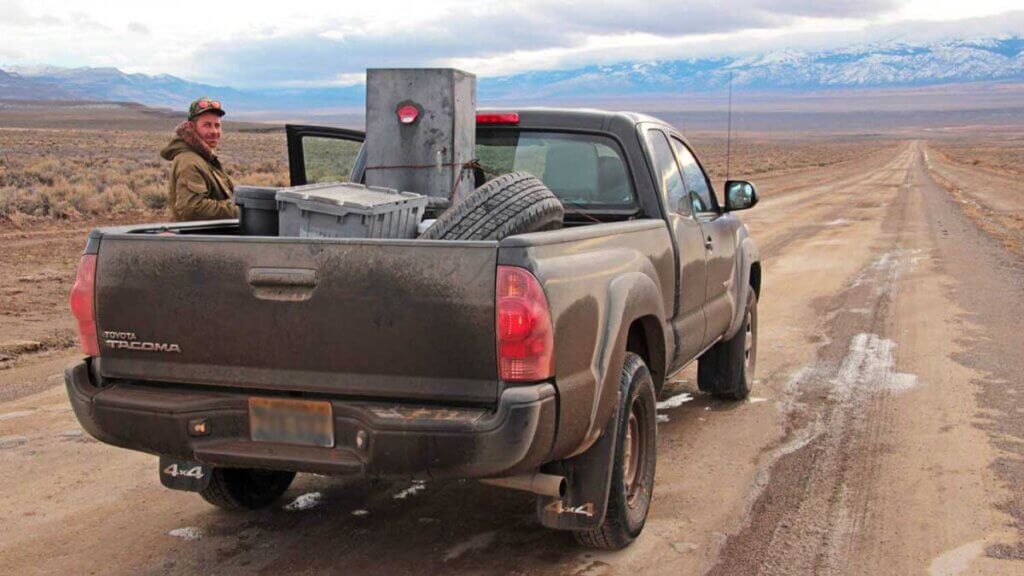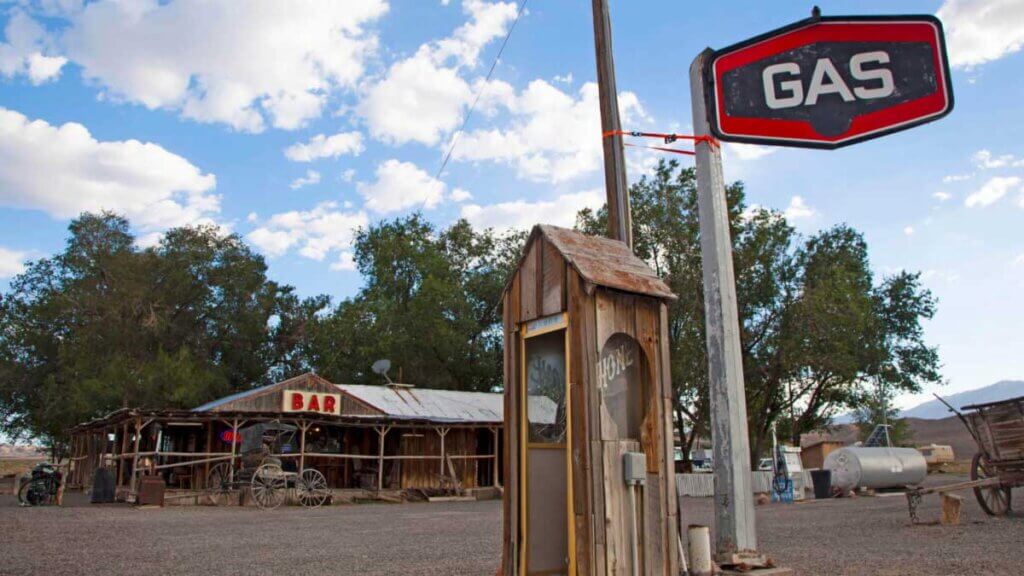
Live By The Dirt Road Code
When we talk about getting a little out there, we ain’t kidding. Nevada has over 60 million acres of land open to the public. That means there are literally thousands of miles of dirt roads, trails, and tracks crisscrossing the state’s wide-open valleys, desert canyons, and more than 300 mountain ranges. Are you ready to get some serious Silver State dirt on those tires (and maybe earn a few honorable Nevada pinstripes—sagebrush scratches—along the way)?
Whether you’re a newcomer waiting to discover Nevada roads for the first time or a dusty ol’ pro who’s slept in a dirt road campground more than their bedroom, brush up on Nevada’s Dirt Road Code. After all, the only good way to leave the pavement is to do so safely and responsibly.
Travel Nevada Pro Tip


Your Dirt Road Campground Packing List
If you’re a first-timer, heading out into Nevada’s backcountry might be daunting. Just know this: The more prepared you are, the better. You’re headed into some wonderfully remote countryside. That means that if you don’t bring something, you’ll have to live without it until you return to civilization.
Only you know what you need to be comfortable on (and off) the road, but here are some tried-and-true items to make your dirt road campground pack list foolproof:
- Headlamps, flashlights, batteries, and a portable generator
- A camping stove, fuel, and lighters
- Cookware, plates, bowls, utensils, and garbage bags
- Camp chairs, coolers, cards, dice, and binoculars
- Pillows, blankets, sleeping bags, and towels (if you’re going hot springing, bring robes, too)
- Sunscreen, insect repellant, and a first aid kit
- Jumper cables, tire patch kit, tow strap, and a jump pack
Travel Nevada Pro Tip
Bring Shovels and an Air Compressor
Most of the time, you won’t need either. However, if you or someone you meet gets into a jam, you’ll be glad to have both. Along with unsticking you, shovels are also handy for tending a fire or creating a makeshift flagpole for your camp.
Pack Plenty of Food and Water
Most people need about a liter of drinking water per day, but you’ll need much more than that for cooking and personal hygiene. Best bet? Get a multi-gallon water jug and fill it at home.
We can’t stress this enough: Pack way more food and water than you think you’ll need. A change in weather or car troubles could leave you stranded for days. Worst case scenario? You don’t use it. Best case scenario? It saves your life.


Always Carry a Paper Map or Atlas
We all own a magical device that shows every spot on Earth in great detail at the touch of a button. But sometimes the magic runs out. In backcountry Nevada, web-based mapping apps (and even GPS) can be wonky, unreliable, and sometimes flat-out wrong. Once you get off the road (or even on the road, in some places), cell service frequently ranges from patchy to nonexistent.
Purchase—or download and print—topographical maps of the areas you plan to visit and travel through. You should also pick up a highly detailed state atlas, which you can find at most gas stations statewide.
Can Google Maps show dirt roads?
Google Maps shows some dirt roads, but it doesn’t show all of them. It also might not indicate whether the road you’re heading toward is paved. In any case, it’s always safer to have a physical map with lots of detail in your back pocket.
Get Good Tires and Know How to Change Them
Many of Nevada’s backroads are in pretty good shape: essentially glorious, dirt-ified expressways where you can zip down the valley. However, once in a blue moon, even if you’re rolling with top-of-the-line tires, there’s a not-zero chance you’ll catch a flat.
Before heading out into the desert, make sure you’ve got sturdy all-terrain tires with good tread. Always travel with a full-size spare and the proper jack and lug wrench to change it. If you’ve never done it before, practice in your driveway. You don’t want your first time to be in the backcountry (or worse, the interstate on the way there).
Top Off Your Tank and Carry Extra Fuel
Fill your tank before you hit the road and always top off before leaving for the backcountry. Gas stations can be few and far between out here. Even smarter: Get a five-gallon can and fill it up. If you need it, you’ll be glad you did, and if you don’t use it…well, that’s five gallons less to worry about when you’re back in civilization.


Pack for All Seasons—Because Nevada
Nevada weather can sometimes be a little out there, especially when you least expect it. It’s not unusual for a June snowstorm to come out of nowhere or for monsoons to suddenly appear in the driest of desert hideaways. Temperatures shift quickly—especially in the desert—so it’s best to pack for all four seasons, regardless of what the calendar tells you.
Some of The Best Dirt Roads Aren’t Really Roads
Grab your atlas and zero in on an out-of-the-way mine, hot spring, or ghost town you want to check out. Some of our favorite places in the state are only accessible by dirt roads, and many don’t even have those. In lots of cases, you’ll take a faded two-track to reach your destination. Sure, they’re a little out there, but that’s a big reason why many of these places still exist.
If you want to get somewhere, odds are you can find a road or track to get you there (or at least a hiking range path). Don’t go blazing your own trail. The desert is a sensitive place, and temporary shortcuts can only damage its flora and fauna.

Learn what you can do to help us keep the places we cherish special—and open—for us and future generations.


Keep Your Distance Between Cars
Tailgating is dangerous. Beyond chipped windshields and full-on accidents, it’s also downright annoying. If you’re cruising down a wide-open valley with someone on your tail, don’t try to lose them. Pull over and let them pass so you don’t have to eat their dust.
Likewise, if you roll up on someone who’s out for a Sunday drive and wants to go slower, they will usually pull off and let you pass. If they don’t get the memo, have the courtesy to back off or go check out some side road for a bit.
Stay to The Right, Even If It Seems Like a One-Lane Road
Stay on your side of the road whenever possible, especially on a blind turn or while ascending a hill when you can’t see the summit. Even if you’ve had the road to yourself for what seems like (and may actually be) hours, there are times when you’ll be surprised by another dirt road rambler coming in your direction, and fast.
In that situation, you’ll be saying a prayer to the dirt road deities, happy you were both on your respective sides of the road with enough room to pass each other.


Always Look Out for Wildlife
Beyond the asphalt, Nevada fauna ranges from rattlesnakes and rabbits to coyotes, antelope, wild horses, burros, and more. And when you’re out here, you’re on their turf. If you’re going so fast you can’t avoid hitting an animal, you’re going too fast.
Keep an eye out for large birds of prey sitting in the middle of the road, too. Although you may assume hawks, eagles, and other large birds will take flight as you approach, they sometimes won’t.
The biggest things that definitely don’t get out of the way are cows. When you see “Open Range” signs—or cows wandering next to the roadside—slow down. A collision with one of them is always bad news for you, your vehicle, the rancher, and the bovine itself.
Slow Down While Driving Through Ranches and Small Communities
Slow down when you hit civilization—whether it’s posted or not—to reduce danger and to keep the dust down. The more you slow your roll, the more locals will appreciate you. Plus, you’ll be on extra alert for spunky ranch dogs that might run out to greet you. If you earn a friendly steering-wheel wave from an oncoming motorist, you’re doing it right.


If The Sign Says “No Trespassing,” Don’t Trespass
When you find a place marked “No Trespassing” or “Private Property,” head back the way you came, even if you think no one is watching. If you can’t find someone to ask permission from, don’t trespass. It could literally mean your life.
It’s safe to say that no matter where you go, the land you’re on belongs to someone: ranchers, someone in the nearest town, a local tribe, or a government entity. And yes, even land that’s considered public may be periodically closed off for any number of reasons.
That said, if a sign tells you that you don’t belong, even if you think you do, you don’t.
Finders Doesn’t Always Mean Keepers
If you’re exploring Nevada’s backroads, odds are you’re going to eventually find some cool stuff. You might come across old mining parts, antique bottles, a century-old hand tool, or a pair of Levis tucked inside a miner’s cabin. Take all the photos you want, but leave your discovery where you found it. It’s on public land, and it belongs to the desert now.
Not only is taking these relics extremely uncool, it’s also illegal. Resist the urge to pillage so the next explorer can have the same experience you did, and our American story can keep moving forward.
Stay Out, Stay Alive
Simply put, old mines and ghost town structures are dangerous. Floorboards break, roofs collapse, and tunnels cave in. Not only does interacting with old structures ruin them forever, they can also be deadly. There’s no good reason to go in or near a mine. They’re full of odorless, deadly gasses and toxic sediments that you’re certain to kick up.


Don’t Be Afraid to Walk
If roads are wet and rutted or otherwise undrivable, don’t run the risk of getting your rig stuck and/or worsening the condition of the road for everyone else. Odds are, if you’ve been cooped up in the car all day, some fresh air and a good leg stretching are exactly what you need.
Get Somewhere for Sunset
Avoid driving at night when you can. Not only is it dangerous, there’s also nothing interesting to look at. Try to end your driving before sunset. Not only will you get to enjoy watching the sun dip behind the mountains, you’ll have more time to set up your dirt road camp.
Remember, the Journey is the Destination
Sure, it sounds cliché, but out here, it’s also true.
Although you’ve got your sights set on getting to a specific place, you wouldn’t even be reading this if you weren’t prepared to embrace the fun of getting there.
There’s no better way to do that than right here in Nevada, so enjoy your trip.
Get Inspired
Related Stories
